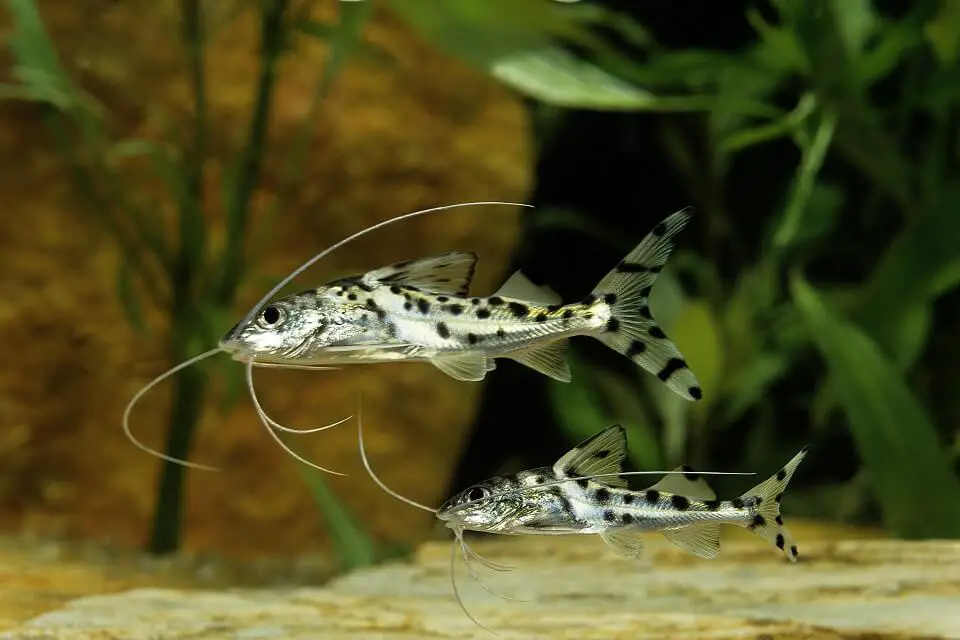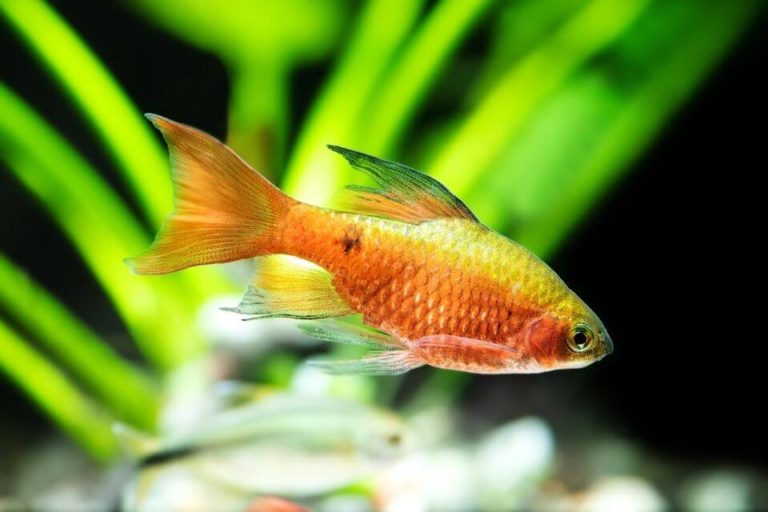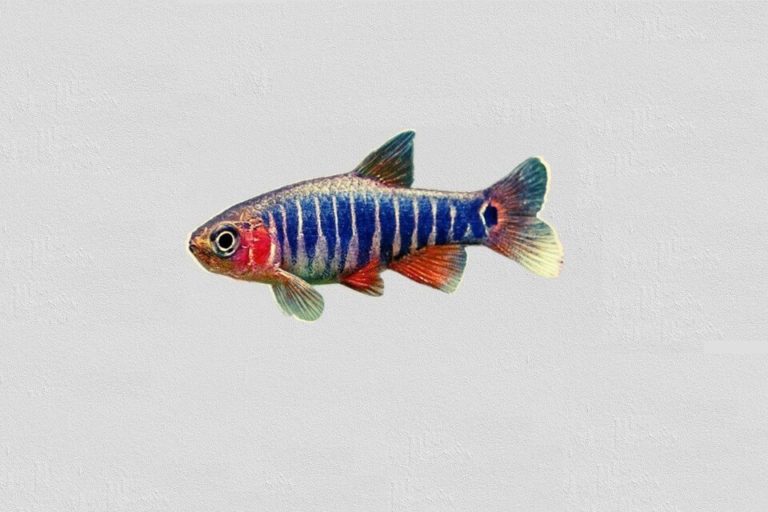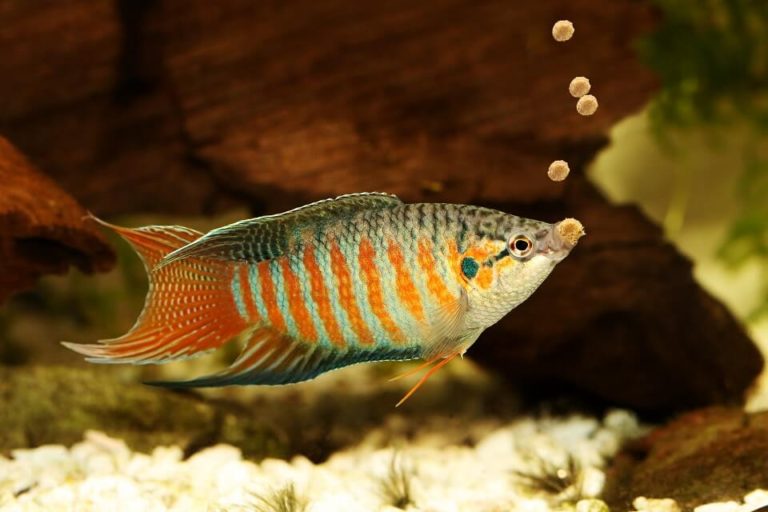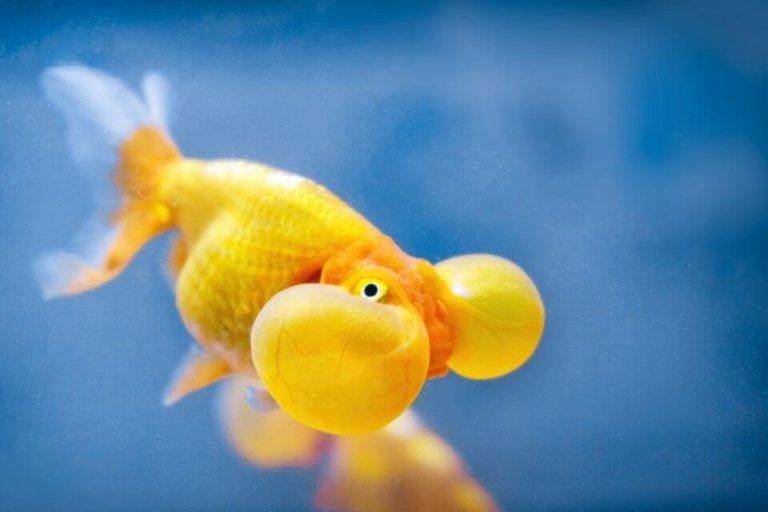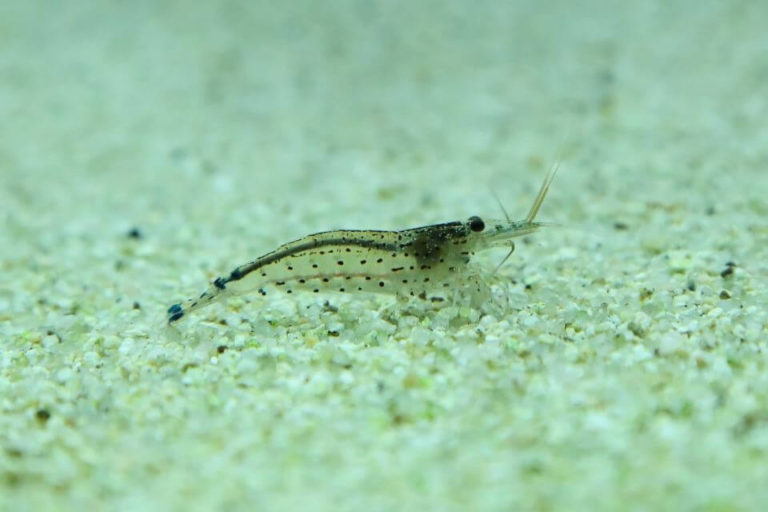Jewel Cichlid Care Guide: Tank Setup, Tank Mates, Feeding and Breeding
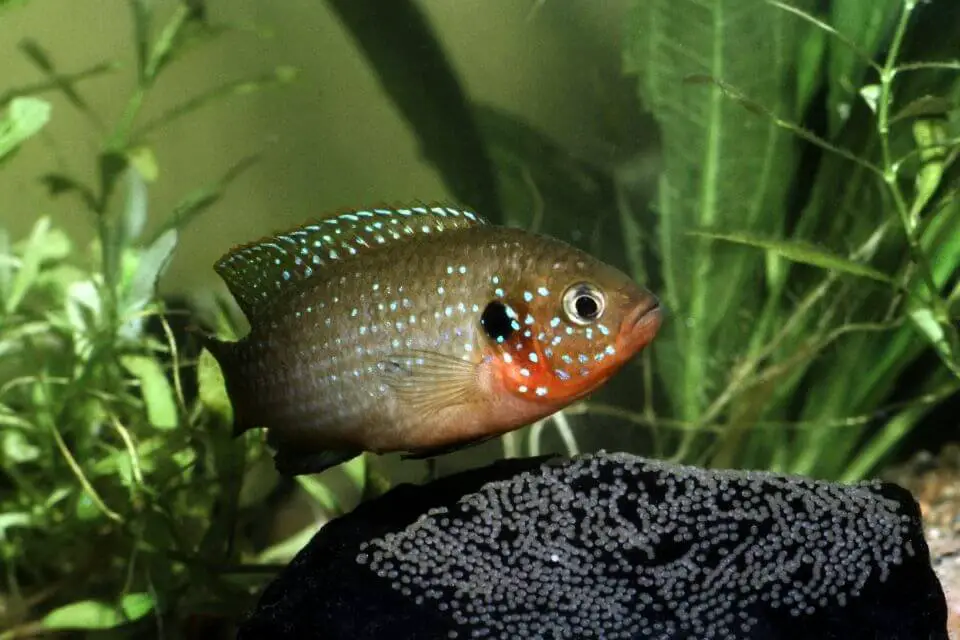
If you are a lover of aquarium fish-keeping or just a fish enthusiast, you may already know about the Jewel Cichlid. From its color to the way this fish survives, it would be intriguing to anyone.
The Jewel Cichlid fish, also commonly known as the African Jewelfish. This is an interesting type of freshwater fish species of the Cichlidae family. It is also scientifically known as the Hemichromis bimaculatus. It is commonly found on the west side of the Africa region and sometimes even on the far east.
You may wonder, why does it have to be the Jewel cichlid? In this article, we will discuss in-depth information on Jewel Cichlid care. This care guide includes how to set up a tank for them, and the general nature of the fish.
All the questions you may have about this species will be answered, and more insight into this already popular fish species.
| Quick Facts: | |
|---|---|
| Common Names | : Jewel Cichlid, African Jewelfish |
| Origin | : Tropical bodies of water in West Africa |
| Family | : Cichlidae |
| Scientific Name | : Hemichromis bimaculatus |
| Care Level | : Moderate |
| Temperament | : Aggressive |
| Social | : Territorial |
| Diet | : Omnivores |
| Size (average) | : 5 - 6 inches |
| Lifespan | : 5 to 7 years |
| Breeding | : Egglayer |
| Minimum Tank Size | : 30 gallons |
| Tank Environment | : Sandy substrate, Rocks, Driftwood, Aritificial aquarium plants |
| Temperature | : 75 – 80 °F (23 – 26 °C) |
| Water Hardness | : 0 - 12 dGH |
| Water pH Level | : 6.5 - 7.0 |
Overview of the Jewel Cichlid
This type of fish is often kept as a pet in freshwater aquariums. This can be attributed to the fact that they are very colorful and attractive, making them worth keeping in your home for aesthetics.
Generally, this fish species cannot be eaten or, at least, is not well known to be food to many people around the world.
They are mostly known to live in freshwater bodies such as rivers and freshwater lakes. Like every other species, the African Jewelfish have variations of color. Between the male and the female that distinguishes them apart.
Although the species of fish are similar around the world, it is essential to note that their characteristics and behavior may vary drastically. These changes may be subject to the specific habitat of the fish.
For instance, the Turkana Jewel in Kenya may exhibit different characteristics compared to the Jewel Cichlid species of the Amazon River. The Jewel Cichlid is said to be very aggressive, unlike other fish.
If you want to keep them in an aquarium, you shouldn’t keep them together with other fish species that are peaceful and smaller.
Origin, Distribution, and Availability
The Jewel Cichlid originated in tropical freshwater bodies in the African region. They are often found in the West African region. Also, found in some parts of middle Africa and the Nile River basin hence the name African Jewelfish.
Also, these fish species can be found in freshwater bodies such as lakes, streams, rivers, and even brackish water lagoons. Jewel Cichlids have been bred widely for aquarium purposes and distributed around the globe for use as aquarium fish.
Since they are popular among fishkeepers, you can find Jewel Cichlid for sale in local pet stores that can find easily. Most online pet suppliers might carry Jewel Cichlid for sale online. If you plan to buy them online you must find a well-known online supplier.
Jewel Cichlid Typical Behavior
These fish species are very aggressive, especially when they are set in pairs and the breeding begins. The more they are in a setting, the more aggressive they become. The Jewel Cichlid breed does not do well with other species of fish and tends to overpower the other fish by being violent.
The fish shouldn’t mix with others in the tank. The high energy in the fish enables them to move in a flirting manner, wiggling their tailfin. If the fish is chasing another across the tank, then that is a sign of aggression.
If the fish is chasing in a circular motion, nipping or kissing, then it is a sign that they are ready for mating. You must watch out for these signs to ensure the safety of the fish to decrease stress and increase their lifespan.
Characteristics of the Jewel Cichlid
Getting familiar with few key characteristics of the Jewel Cichlid is not going to be time-westing. So, the below discussed basic facts might give you an idea of the appearance of them whether you plan to have one or not.

Appearance, Colors, and Special Markings
These fish species are generally narrow and thin. The anal fins are shallow and are a bit far from the dorsal fin, while the dorsal fins start about a third of the body down to the caudal fin.
The head of the fish slants upwards from the mouth and starts to curve into bumps. This bump is more visible when the fish is younger
The most common of the Jewel Cichlid colors are the Red Cichlid. This can be attested to by the number of fish already caught and in the aquariums all around the world.
But this is not the only color that this species comes in; they come in Blue or Green and are given their names according to the color they have. For instance, the blue jewel or the green jewel and commonly found in the Red Jewel Cichlid.
Despite the color of the fish, the fins of the fish are usually more stripes than the dotted pattern of the body, which adds to the beauty of the fish’s appearance.
Jewel Cichlid Size
The Jewel Cichlid size varies from one to another. In the captivity environment the normal growth range from 5.5 inches to 6 inches. If you provide extreme care with a nutritious diet plan the fish may grow up to 7 inches long ever it is in captivity.
In the wild, the reported grown Jewel Cichlid size is up to 12 inches that is impossible in the tank environment even you gave them extreme care.
Life Expectancy
The Jewel Cichlid fish has a lifespan of about 5 years, which is quite long for a fish. On rare occasions, does the fish live up to around 7 years. Several factors influence the lifespan of the fish, for instance, the habitat provides and the care given.
If the habitat is conducive and enough care is given to the fish, a lifespan of at least 5 years will be achieved. Another way to ensure that the fish can live longer is by managing their aggression.
Stress that can come from the African Jewelfish sharing a talk with other fish or fights can also significantly reduce the lifespan of the fish.
Aquarium Care and Conditions for Jewel Cichlid
The care needed for the Jewel Cichlid is mainly due to their aggressive nature. Thus, one should know the major guidelines on the tank setup and the food required to ensure that the fish survive their stay and live to their maximum lifespan.
Tank Condition and Care
The tank should have stones and wood for covering until the set in the tank is ready for breeding. Depending on the size of the tank, then as an aquarist, you will be able to decide the kind of layout you want and the tank set up for the fish.
Ensure that the tank has very clear water and that the water in place is as clean as possible. The proper filtration system is often necessary to filter out any substances that may be harmful to the fish inside the tank.
The same filtration is required when administering medication into the water inside the tank to keep out carbon, as carbon takes out the medication. It may reduce the chances of survival suppose the fish is sick.
Jewel Cichlid Tank Size
The tank in which you put the African Jewelfish should be more spacious, that you may prefer to use a minimum of 30 gallons tank. But a little more spacious above the 40 gallons capacity should be considered, especially if you are thinking of putting these Jewel Cichlids with other fish species.
A bigger tank is recommended because these fish species are very territorial and aggressive; enough space will ensure that they can maintain their territory.
If the fish paired in the tank are both of the Jewel Cichlid species, then the extra space is meant to reduce the rate of aggression by creating enough space for the fish to be distant.
Tank Setup
The lighting of the fish tank can also vary depending on the color of the Jewel fish in the tank. You may want to use more fluorescent lighting or neon lighting but in moderation to highlight the beautiful colors of the fish.
To replicate the natural habitat of the fish may be essential in ensuring that the fish are very comfortable. Another advantage of keeping the fish with other things in the tank is that it allows you to keep multiple fish together.
With rocks and wood in the tank creates room for other fish to hide from the more aggressive ones. Putting in the tank sandy substrate will ensure that the fish do not cut themselves when they swim.
A background of plants is necessary to create a more homely feeling for the fish. It is advisable that you do not pot in live plants because there is a high possibility, they will not survive the aggressive nature of the fish.

Suitable Plants
Suitable plants to put in the tank together with the Jewel Cichlid would be green artificial plastic plants. this is because the aggressive nature of the fish would not allow for the natural plants to survive.
But if you place the plants that have a strong rooting system would survive among these aggregation species. Java Fern would be an ideal choice as to live plants.
Water Conditions and Parameters
The water in the tank should be freshwater as the fish do not survive in salty water. The water in the tank should not exceed 12 dGH. The pH of the water should be maintained between a range of 6.5 to 7.5.
The temperature of the water should also be more of room temperature, from the range from 75°F to 80°F (22 – 26 °C) for the fish to be able to survive.
- Temperature: 75 – 80 °F (23 – 26 °C)
- Water pH: 6.5 – 7.0
- Hardness: 0 – 12 dGH
Jewel Cichlid Diet and Feeding
These fish species are easy to feed, so they are quite easy to manage. The fish are omnivorous and mostly feed on fish flakes, live food, and pellets. Like any other animal, for better chances of survival, the more balanced diet you give the fish, the better for them.
You could mix the fish flakes and the pallets for several days of the week and then switch it up with live food. This routine ensures that the fish does not get bored with a specific type of food.
For live food, the most recommended ones are the bloodworms, the shrimps, and the frozen brine. Be careful not to exceed the maximum limit for the fish and feed the live food in excess.
The flakes are specifically important for the fish to maintain their color and great health. You may want to throw in some vegetables such as Spinach in the tank to ensure that the fish enjoy a green diet. You could also add some algae wafers to the fish food diet.
Common Diseases of Jewel Cichlid
The freshwater fish disease is most common in the Jewel Cichlid fish. You will be able to note that the fish is sick from the way it behaves. The fish is naturally very energetic; when the fish’s energy levels are below normal, then there is a course for alarm.
This disease is brought about when the fish is stressed. Stress can come from different factors such as transport from one place to another or acclimatization. To avoid such, ensure that the fish is properly acclimatized before you introduce it to the main tank.
The quality of the water should also be checked to avoid stressing the fish. You should quarantine your fish in a separate tank with proper nitrogen circulation until it gets better before re-introducing it to the main tank.
Before medicating the fish, ensure that all the quality checks have been made. If this does not improve the condition of the fish, then you can medicate. Remove carbon from your filtration process before any medication.
Any aquarist is required to have an aquarium test kit for such incidences.
Gender: How Can You Tell If A Jewel Cichlid Is Male or Female?
It is very difficult to tell the gender of any fish just by looking at it. But upon close examination, it is very easy to tell which fish is female or male. For instance, the male African Jewelfish is more colorful and larger than the female Cichlid.
This coloring is specifically more colorful during the mating season. The fish have the same small spots covering their whole body, so it is difficult to tell from a far distance. The male spots are iridescent and are mostly in the shade of yellow and aqua.
They also have a large black gill spot on each side, behind the head. The fins of the male are more pointed. The female fish, on the other side, has spots that appear to be silver or white. The fins of the female are more rounded than pointed around the edges.
Jewel Cichlid Breeding
The cichlid is a very monogamous fish. After breeding, the mates often grow closer together. The fish often move in circular nature when they want to mate, and it is very flirtatious. They will keep nipping at each other (kissing-like movement with their mouths touching).
Jewel Cichlid breeding is quite easy once you have already determined the gender of each. The aggression of the fish is quite high when they are mating; enough space is required for each pair. To create the best suitable conditions for the fish to breed is to increase the water temperature in the tank by at least 2 degrees.
The male will become more colorful and vibrant when ready to mate, and the female Cichlid will look below the rocks for the most suitable flat rock to lay eggs on.
The eggs become fertilized after 2 to 4 days, and after hatching, the parent cichlid will move other fish species to the other side and become more aggressive to protect the younger fish.
Feeding the younger fish will require a dinner diet of shrimps and baby brine for faster growth.

Jewel Cichlid Tank Mates
The African Jewelfish doesn’t do very well in a community tank. However, some experienced aquarists have managed to keep the Jewel Cichlid with other types of fish, such as the Tetras. The fish may survive in a tank with a specific breed of fish but no other Cichlids.
They tend to be more aggressive to their kind. It is not advisable to use a community tank when housing this particular fish; they could survive their kind but make sure to make the tank big enough due to their territorial nature.
Can Jewel Cichlids Live Together?
The Jewel Cichlids can live together in very large aquarium tanks. If the fish are well acclimated with the water, the food is enough, and all the relevant quality checks are suitable for the fish, they can live together with other fish.
Putting them together is also very important for the fish, despite their aggression. It creates a familiar environment for the fish to swim in like that of the river, and they are also able to breed when put together with their male counterparts.
It also helps reduce stress in the fish, making them healthy and live longer.
Are Jewel Cichlids Aggressive?
The aggression of the African Jewelfish has been mentioned throughout the article. This Is quite true and a cause for concern for every aquarist. Their aggression is the reason why they are difficult to place together with other species in the community tanks.
They are said to have so much energy, and this gets worse when they are in the mating season. Their aggressive nature does not even allow for live plants in the aquarium because they would kill the plants.
Can Jewel Cichlids Live with Oscars?
Jewel Cichlids can live with Oscars but not for long. The nature of the cichlid will not allow for the Oscars to survive. Unlike the cichlids, the Oscars are known to be a very peaceful breed of fish.
Again, the aquarium conditions for the Cichlid’s effective survival greatly vary from that of the Oscars. Putting them together will mean that the Oscars will live loud as greatly stressed fish and may even shorten their lifespan.
How Fast Do Jewel Cichlids Grow?
It takes 2 to 4 days for the African Jewelfish eggs to be harsh. With proper feeding of the shrimp pellets and the baby brine, and most importantly, a balanced diet, it will take at least 3 weeks before the fish can swim.
In a span of 2 to 3 years, the fish may have grown to its maximum level. This fish’s growth is quite moderate, and after the 3 years, the fish will most likely be about 5.5 inches (14 cm) long. This is not the final size of the fish, as it is set to grow even bigger with time.
Do Jewel Cichlids Have Teeth?
All of the Jewel Cichlid species have teeth. Different types of Cichlids have different types of teeth. The teeth are not strong enough to bite you, so there is no need to worry. Some of the Cichlids have smaller row teeth and are designed to eat algae that grow on the rocks.
Cichlids with such teeth mostly feed on plants and algae that grow on the rocks. Those Cichlids that are carnivores in nature exhibit a different pattern of teeth.
Their teeth are sharper and fang-shaped to allow for grasping of live food such as the shrimp. While some may want to bite you, this happens on very rare occasions, and the bite will hurt depending on the size of the teeth.
How Do I Know If my Cichlids Are Mating?
It is very easy to tell if your Jewel Cichlids are mating. This has been discussed earlier in the article, the fish tend to be more aggressive during the mating season, so it is easy to tell that they are mating.
The female Cichlids will always move in a circular motion to indicate flirting, and after some time, it will try swimming at the bottom of the tank, searching for a flat rock to lay eggs. The male cichlid will also become more vibrant and colorful, an indication that it is ready for mating.
If you are not a keen aquarist or you are just busy, and you have paired both the male and female cichlids together, after a while, you are bound to see smaller fish in the tank that is a clear sign that your Cichlids are mating.
Can Different Cichlids Breed Together?
It is very common to have a hybrid of the Cichlid’s species, a clear indication that the fish can breed with each other despite their different breeds.
This process can be naturally occurring in the rivers and water bodies but can also be done scientifically in the captivity environment. The Cichlid breeds’ hybrid is very attractive and has given rise to a new breed of Jewel Cichlids.

Final Thoughts of Keeping Jewel Cichlids
The African Jewelfish is a very interesting fish species, and that is why it is preferred by a lot of aquarists. As part of the tropical fish, it exhibits characteristics of high energy and aggression while maintaining its beauty.
With the information on this guide, you can now keep the Jewel Cichlid in your home aquarium. If your heart is set on having a community tank, it is better that you avoid such fish for you to keep more.
If you love to keep the Jewel Cichlids, the care given to the fish is quite easy and when kept with others of the same breed and species. The fish is set to live longer.
Care and maintenance of the African Jewelfish are very straightforward and intriguing. Even without the comfort of other fish to add variety to your tank, as an aquarist, the Jewel Cichlid is enough for you and is highly recommended.


